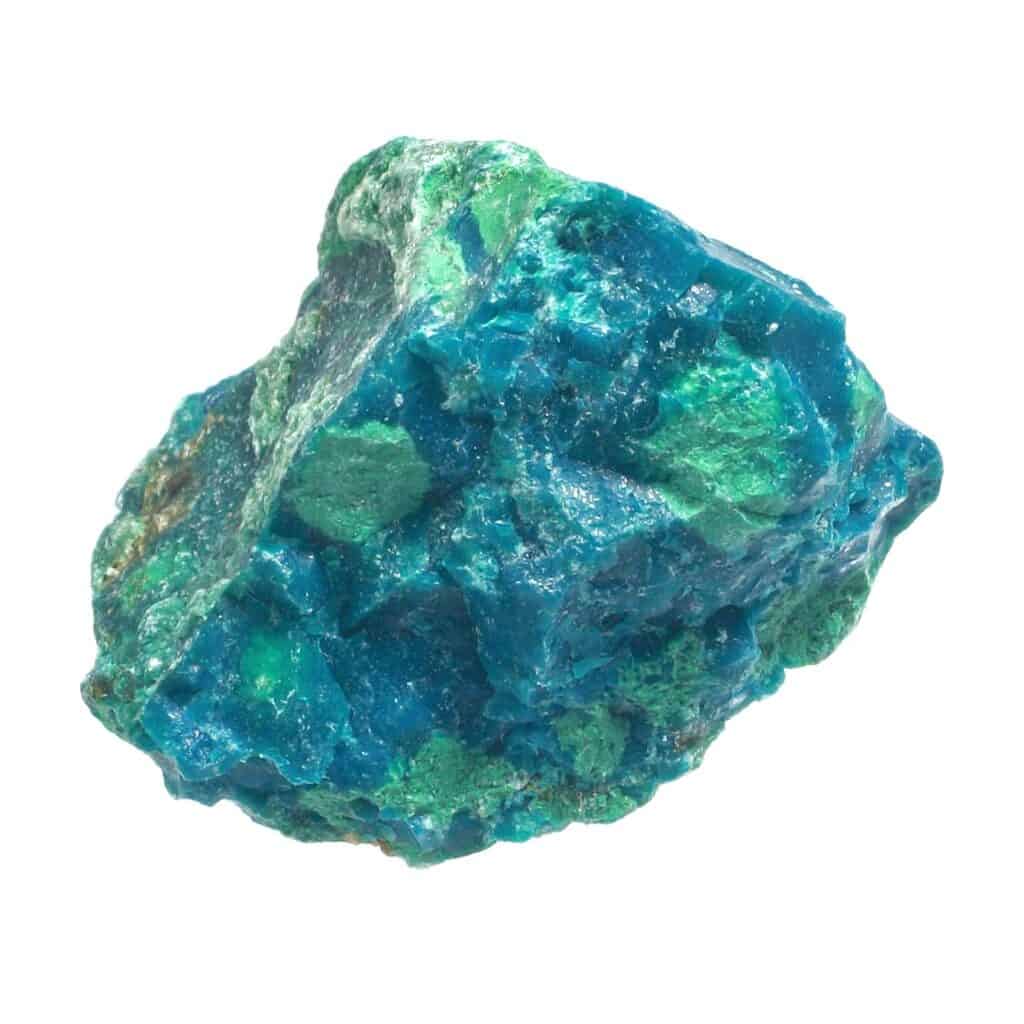
The name of Gemstone ‘Chrysocolla’ is derived from the Greek word “chryso-” which means gold and “kolla” which means adhesive material.
In ancient times, goldsmiths used a variety of ores to connect gold into alloys, one of which was chrysocolla, hence the name.
However, it is uncertain whether Chrysocolla at that time and Chrysocolla today refer to the same mineral.
There are many stones with intricate black and brown patterns on the blue, light blue, and green backgrounds.
The bright blue one is mistaken for turquoise (turquoise) and may actually be sold as turquoise.
Benefits of Chrysocolla
Following are the benefits of Chrysocolla:
- Emotional stability,
- improved immunity,
- prosperous business,
- successful work,
- happy family life,
- beautiful hair and skin,
- expressiveness
Healing effects of Chrysocolla:
Chrysocolla is said to emit waves that act on the nervous system and has the effect of stabilizing emotions. Therefore, as a talisman for the healthy growth of babies and children, adults can use it as a talisman to disperse vague anxiety, fear, and guilt and balance emotions.
Also, if you are dealing with computers or electronic devices, it will help reduce frustration and prevent emotional shorts.
In the field of stone healing, it is used to boost immunity, promote iron absorption, avoid skin pigmentation and create beautiful hair and skin.
If you are suffering from nervous gastrointestinal problems, it seems that having this stone has a suggestive effect that stabilizes your emotions and may reduce your symptoms.
However, these effects and benefits have not been proven in modern medicine.
Magical effects of Chrysocolla:
It is a stone that is often used as a healing stone, and is said to emit waves that act especially on the nervous system (for details, see the item “As a healing stone below”).
Chrysocolla has long been regarded as a stone that symbolizes prosperity, good luck, and successful work.
It is also said to support expressiveness and sensitivity. It is often said to inspire and enrich aesthetics in creative relationships, inventions and jobs that require creativity.
In addition, it will be a supporter to express the feelings that you have accumulated in your heart, so it will be a good amulet when you confess to the opposite sex or give a presentation at work.
How to Cleanse Chrysocolla
We recommend incense, moonlight bath, or purification with crystal. We do not recommend washing with water or the crude salt method.
The most recommended purification method is to burn the leaves of white sage and let the smoke lightly pass through the stones.
Chrysocolla corresponds to which chakra:
Throat, chest, mid-belly
Directions corresponding to Chrysocolla:
North, east
Properties of Chrysocolla
| Mineral name | Silicofluoride malachite (Kei Kujakuishi) Chrysocolla (Kurisokora) |
|---|---|
| alias | — |
| Misnomer | — |
| Main production areas | Mexico, USA, Russia, Congo, Israel, Peru, United Kingdom |
| Classification | Silicate mineral |
| Chemical composition | Cu 2 H 2 Si 2 O 5 (OH) 4 · nH 2 O Compound of copper, water molecule, hydrogen, silicon, oxygen |
| Crystal system | Monoclinic system |
| Crystal habit (shape) | Massy, grape-like |
| Main shades | Blue, turquoise, green |
| Streak color | Light blue, tan, gray |
| hardness | 2-4 |
| cleavage | None |
| specific gravity | 2.0-2.4 |
| Refractive index | 1.46 ~ 1.57 |
| Similar stone non-made | Turquoise |
It is a mineral formed in copper veins, and strictly speaking, chrysocolla itself is a fine granular crystal. However, in reality, it is often coexisting with malachite (peacock stone) that also crystallizes in the copper deposit to form a lump, and since the main component is silicate, it was named chrysocolla.
Chrysocolla itself is very fragile and has a hardness of 2 to 4, but in many cases it is in a state of closely coexisting with quartz, chalcedony, opal, etc., in which case the hardness increases.
In particular, the one that has been soaked with quartz and solidified in its natural state has a hardness of 7, which makes it possible to polish it. In the United States, this is called “Gem Silica,” which is very popular as a jewelery item, and good quality ones are highly priced.
Chrysocolla from Eilat, Israel, coexists with turquoise, malachite, and azurite. What is called “Eilat Stone” has a legend that it is a stone held by King Solomon.
Recently, a stone in which a total of four types of shatterkite, malachite, and smoky quartz coexist, centering on chrysocolla, is sometimes called the distribution name “Quantum Quattro Silica”.